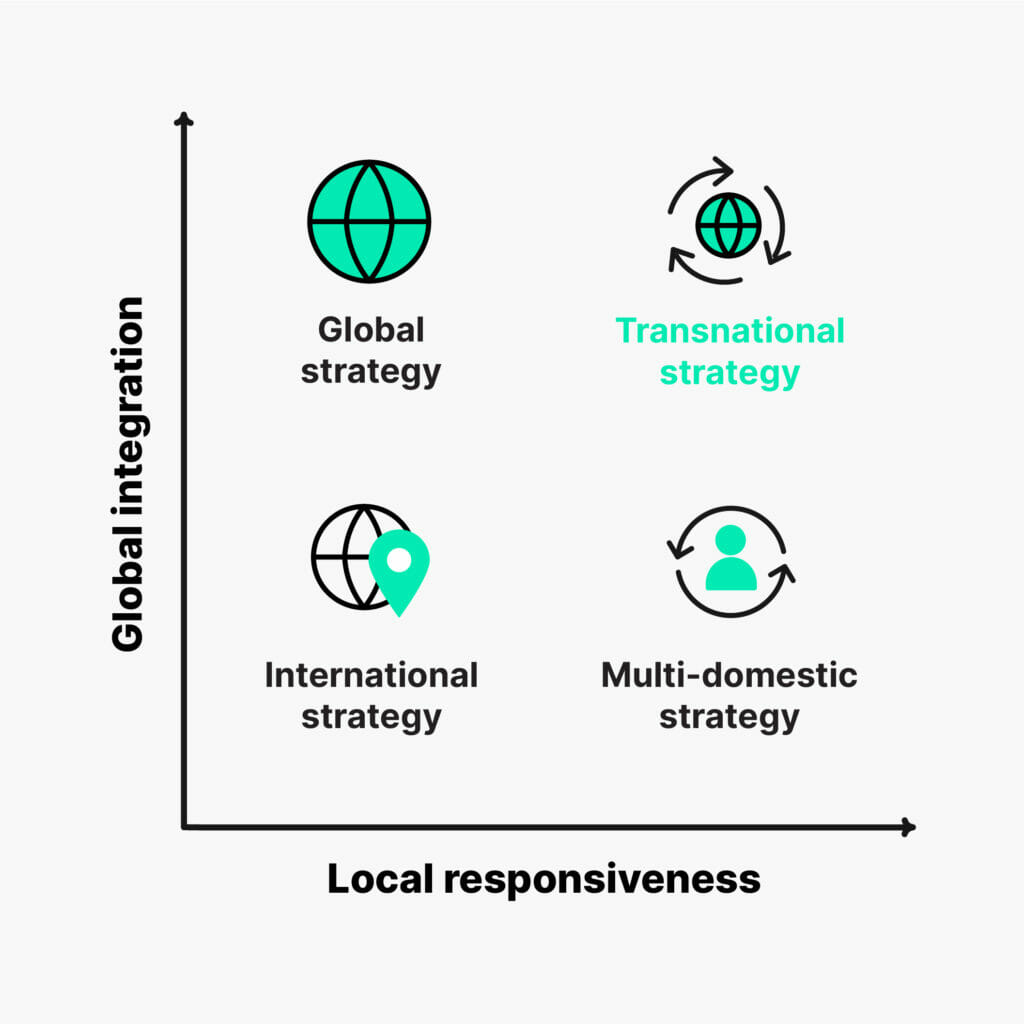Transnational strategy is a type of global expansion strategy that companies use to combine high responsiveness to local preferences with greater efficiency and cost savings. To help you get a better understanding of why and when a growing business can employ a transnational strategy, this guide will walk you through its basics and compare it with other global expansion strategy types. You’ll also get to know some strong transnational strategy examples and learn implementation best practices.
What is a transnational strategy?
Companies applying a transnational strategy partially adapt to local preferences while also seeking greater efficiency and lower costs—combining elements of both a global and multidomestic strategy. As a result, transnational companies are highly responsive to local needs and use standardization across their operations to achieve economies of scale.
Being closely attuned to their markets and customer demands allow them to know when the return on investment from customization is enough to justify any partial differentiation. Since more customization adds costs and complexity, these organizations must continually strike a balance between local preferences and reducing costs. A well-executed transnational strategy can be highly profitable.
Transnational strategy is one of 4 global expansion strategies, The others being multi-domestic strategy, global strategy, and international strategy. Each strategy has unique benefits and differences because they prioritize different approaches to reaching international markets.
No strategy is best for all businesses—factors such as business goals, industry, size, and others determine what type of strategy will most benefit a specific company. Organizations that are considering global expansion would benefit from carefully considering each strategy’s possibilities and limitations within the full context of their capabilities and potential.
How a transnational strategy differs from other global expansion strategies
Transnational strategies differ from other global expansion strategies with regard to local responsiveness, customization, global integration, and customization. Because no company can maximize all 4 areas simultaneously, organizations choose to prioritize their emphasis through particular strategies.

Global expansion strategy pressures
All 4 of the global expansion strategies represent key differences and are characterized by 2 pressures—global integration and local responsiveness.
Global integration and standardization
Products and services that are standardized are largely the same, with little or no customization, for every market. Other functions, such as marketing, could also be standardized among different markets.
Companies that operate across national boundaries may produce standardized products in order to reduce costs on a per-unit basis and increase efficiency.
Local responsiveness and customization
By customizing products and operations for different markets, organizations can create purpose-built offerings and pursue a strategy of appealing to localized needs and expectations. These companies target customers who value adaptation to a specific context.
Both global integration and local responsiveness could be seen as operating on a continuum. Low-to-high global integration and local responsiveness form the basis of different global expansion strategies.
Types of global expansion strategies
As a quick review, there are 4 different global expansion strategies—3 aside from transnational strategy:
Multi-domestic strategy
Products and services for each distinct country’s market are customized with a multi-domestic strategy with the goal of making the organization’s offerings more competitive. Multi-domestic strategy is highly responsive to local preferences, but also less globally integrated.
Because global integration is low and responsiveness is high, applying a multi-domestic strategy can be more expensive than a strategy with low responsiveness, such as an international strategy.
Global strategy
A global strategy focuses on cost-effectiveness and efficiency in worldwide products and services. Within every market, companies using a global strategy offer the same or very similar products. Organizations strive to be the cost leader in their markets.
High global integration and low responsiveness are typical for a global strategy. A global strategy is usually best for product categories where customization isn’t important, but price is an important factor customers prioritize.
International strategy
An international strategy doesn’t significantly change the pricing or features for a new target market.
What are the benefits of a transnational strategy?
A transnational strategy aims for “the best of both worlds,” capturing the responsiveness advantage of a multi-domestic strategy alongside the cost and efficiency advantage of a global strategy. Customization saves transnational organizations some of the resources they would otherwise have to invest if they chose a multi-domestic strategy. At the same time, these organizations can focus on building their brands within overseas markets.
Multi-domestic companies create separate products and services for each market, while global strategy companies give up local responsiveness for greater cost savings—transnational strategy is distinct from either approach and is able to be locally competitive and efficient. Some supply chain efficiencies common to global strategy can be realized in transnational strategy while maintaining local responsiveness.
Top 5 transnational strategy examples
Succeeding across the globe in a range of industries and environments, transnational companies often range from mid-size to large enterprises. Businesses that want to employ a transnational strategy should be prepared with the financial resources and strategic management guidance necessary to enter global markets.
Some of the best examples of transnational strategy are well-known companies, such as Walmart, Google, Unilever, KFC, and Costco.
Walmart
In competing globally through cost leadership, Walmart keeps prices low for their customers in every market and can leverage supply chain efficiencies. At the same time, Walmart customers can find products and store-level customization to local preferences based on extensive analysis and ongoing updates to the products carried locally.
Although Walmart operates different store brands in different countries, many of which the company purchased, stores together as a global organization can take advantage of strong purchasing power and international supply chains.
By working locally to improve responsiveness and using local offices to serve niche markets overseas, Google demonstrates a transnational strategy. Google is also known for heavily prioritizing efficiency. Emerging markets get their own emphasis and focus from the company, making it easier for customers to get the quality they need.
Unilever
In order to provide local markets with customized goods, the consumer products company Unilever uses independent, self-sufficient subsidiaries and localized production around the world. Local companies, of which there are around 500 different units, are able to guide their own strategy to a great extent and manage their operations with local needs in mind.
Although cost is also important at Unilever, consumer products such as Lipton Tea should be high quality and accessible, driving purchasing and brand engagement from customers.
KFC
As a major buyer of chicken, the KFC fast food brand realizes significant supply chain savings—but KFC restaurants serve local menus that provide a high degree of responsiveness to customer preferences. Although best known for fried chicken and Southern US-style sides such as mashed potatoes, corn, and french fries, KFC locations around the world can serve recipes that cater to local tastes. For example, customers in Thailand can order green curry chicken at KFC, and in Indonesia, you can get a bento box meal.
Costco
Localization is essential for the global retail giant Costco, as is the volume sales generated through being a cost leader. A transnational strategy provides Costco with the perfect balance and has represented a smart approach to continued growth into a global brand.
In each country, Costco offers different products that reflect local tastes and preferences. Costco’s food court has unique menus – with items such as poutine available in Canada and seafood pizza at Taiwan stores.
Realizing the benefits of global expansion
In finding the right global expansion strategy for your organization, you can reach new international markets and grow your customer base. Global companies have the opportunity to reach new goals and establish stronger brand identities.
A transnational strategy can help your business expand overseas by positioning your company to compete both on local preference and with price leadership. For these reasons, this strategy might be the right fit for your organization.





